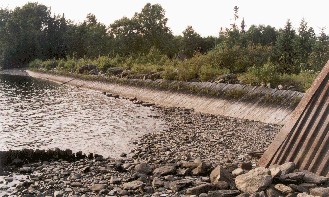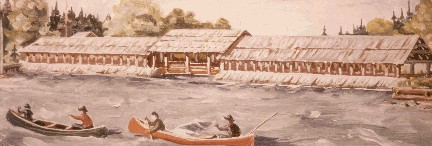DACF Home → Bureaus & Programs → Bureau of Parks and Lands → Discover History & Explore Nature → History & Historic Sites → Lock Dam
Lock Dam
 Built by Eben S. Coe (on behalf of owner David
Pingree) in the 1850s, Lock Dam was designed to allow the
transfer of logs from the area around Eagle and Churchill
Lakes down into the Penobscot River Basin by adjusting the
water levels in the locks and floating groups of logs from
Eagle Lake over to Chamberlain. From there, they could be
driven downstream to Telos Lake and through the
Telos Cut. This process greatly expanded the acreage of
timber that could be brought down to Bangor mills and markets,
but the slow rate of the lock process limited the number of
logs that could move through in a given period of time. By
1906, Lock Dam was abandoned as a log moving method in favor
of the mechanically powered Tramway.
Built by Eben S. Coe (on behalf of owner David
Pingree) in the 1850s, Lock Dam was designed to allow the
transfer of logs from the area around Eagle and Churchill
Lakes down into the Penobscot River Basin by adjusting the
water levels in the locks and floating groups of logs from
Eagle Lake over to Chamberlain. From there, they could be
driven downstream to Telos Lake and through the
Telos Cut. This process greatly expanded the acreage of
timber that could be brought down to Bangor mills and markets,
but the slow rate of the lock process limited the number of
logs that could move through in a given period of time. By
1906, Lock Dam was abandoned as a log moving method in favor
of the mechanically powered Tramway.
Lock Dam was originally a timber crib dam. It is no longer
that type and had not been for many years prior to the establishment
of the Allagash Wilderness Waterway in 1966. The original
timber crib structure on Chamberlain Lake, built as one of
two dams providing a lock between Chamberlain and Eagle Lakes,
had deteriorated, collapsed, and was buried under an earthen
dike before the Waterway was established in 1966. Since that
time, Lock Dam on Chamberlain Lake has been an earthen embankment
with sections of parapet wall that consists of embedded vertical
spruce planking or logs and a promontory lined with a corrugated
steel bulkhead and riprap extending 3-5 feet above lake level.
A 3’ diameter, gated culvert spillway, which predates
the Waterway, allows discharge of water into Allagash Stream
below Lock Dam and provides water for canoeing to Eagle Lake.
No vestiges of the second lock dam at Eagle Lake remain.
DPPL acquired Lock Dam along with Telos Dam and their
associated structures in 2000 in order to continue management
of water levels consistent with the Waterway’s management
objectives and to prevent changed or expanded private use
of the associated buildings in a manner inconsistent with
the Waterway’s management objectives. The dams are maintained
and managed by DPPL as part of the Waterway. DPPL
has no plans for these dams, except to improve their condition
and maintain them, nor does DPPL intend to change the
flow regimes from those currently in effect.

"As it looked from the twenties thru the mid-forties. Then the roofs came down over the walkways - with the roof over the gates lasting quite a few more years!" -- interpretive panel from a few decades ago.